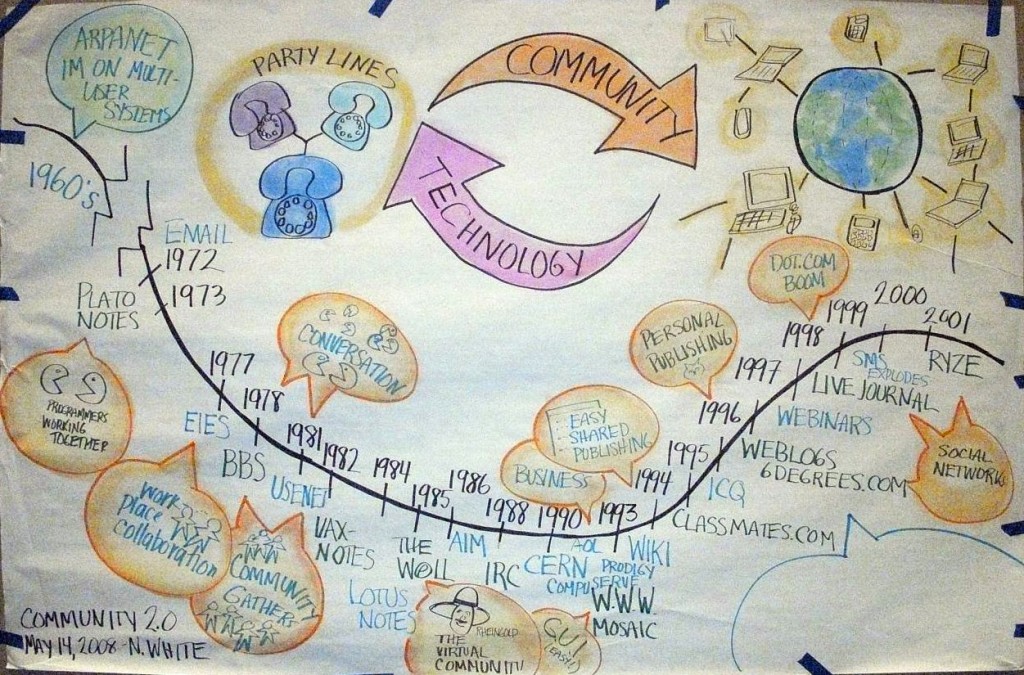I’m a big fan and practitioner of The World Cafe way of convening conversations that matter. Here is a quick video featuring the amazing Samantha Tan, giving an overview of The World Cafe. If this is a new approach for you, take a look!
Category: facilitation
References on Lurking
 I was asked about some useful references on lurking and lurkers this week, so I thought I’d refresh myself with a few that I like. (I’ve written about ithere on the blog quite often over the years!)
I was asked about some useful references on lurking and lurkers this week, so I thought I’d refresh myself with a few that I like. (I’ve written about ithere on the blog quite often over the years!)
Personally, I’m of the school of thought that lurking is a form of legitimate peripheral participation, that in most cases, if everyone actively participated we’d be overwhelmed, that we often and appropriately lurk offline and that lurking is not always “take and no give,” that people do in fact take what they learn one place and often use it and contribute elsewhere. It is more generalized reciprocity.
First, is an old discussion summary from the Online Facilitation list from 2003, compiled by Chris Lang which still has value to me. You an find it here TIPs for Facilitating Lurking
Second is another distillation of conversation, this time from CPSquare. Download file.
Of course, this has been studied in the academic community, such as this paper on why lurkers lurk, from Jenny Preece and Blair Nonnecke (pdf prepub).
Finally, some fine blog posts on lurking by friends and colleagues. (Edited to add more links March 30)
- Christopher Allen on Power Laws
- Ton Zylstra on Lurking and Social Networks
- Jacob Nielson on Participation Inequality
- Andrew Gent’s personal reflections on his own lurking
- Jack Vinson’s Beyond Lurking
- Francois Gossieaux- Active Lurking
- Tom O’Brien Degrees of Lurking
My bottom line is one’s approach to lurking is context dependent. If full participation is a stated requirement (as in a job or a course) one must find ways to facilitate and enable that participation. The larger and more open the group, the more lurking is a natural and expected behavior.
Photo Credit:
ITC Keynote: The History and Future of Online Facilitation
Wow, they got the video up fast, so I guess there are two Monday videos today! Here is a recording of the keynote I did a little over 90 minutes ago! The presentation wiki has slides and I’ll reflect on the Twitter backchannel experiment (and thank all the Twitterfolk who helped make it happen) later in the week.
Online Facilitation 13 Years On: What We Learned and What Do We Need to Learn?
What is YOUR history of online facilitation?
 In just over a week I’ll be in Ft. Worth, Texas, opening Monday’s session of the Elearning 2010 Conference. My topic is “Online Facilitation 13 Years On: What We Learned and What Do We Need to Learn?” Despite all best intentions, I’m just now getting concrete on what I want to do in this more traditional ‘podium’ opportunity. There are so many things we could talk about. So I’m wondering, what is YOUR history of online facilitation? What are the key turning points for you? And what do you see in the future?
In just over a week I’ll be in Ft. Worth, Texas, opening Monday’s session of the Elearning 2010 Conference. My topic is “Online Facilitation 13 Years On: What We Learned and What Do We Need to Learn?” Despite all best intentions, I’m just now getting concrete on what I want to do in this more traditional ‘podium’ opportunity. There are so many things we could talk about. So I’m wondering, what is YOUR history of online facilitation? What are the key turning points for you? And what do you see in the future?
The fabulous ScOPE online community asked these sorts of questions in a 2007 online event facilitated by my friend Nick Noakes, and it was fun to go back and reread them. (Link here, or SCoPE_ Seminars_ Online Fac. PDF)
Here is a little context from me:
I have been living, breathing, obsessing about online facilitation since 1996-97 when I fell down the online community rabbit hole in Howard Rheingold’s Electric Minds. I sensed something important, and sought to give voice to that intuition over the past 14 years. (Funny, when we set on the title, it was 13 years. oops!) Using only my offline facilitation experience, I dove blindly in, sometimes flying, sometimes crashing and burning.
Over the years I started to write about what I was learning and point to the giants upon whose shoulders I stood. Online, that meant among others, Peter and Trudy Johnson Lenz, Jessica Lipnack and Jeffrey Stamps (for their virtual team pioneering work), Lisa Kimball and the folks at Metanet, Liz Rykert, Howard Rheingold and all of the hosts and facilitators at Electric Minds (old and newer), The Well and the myriad of other communities I have belonged to. Offline I built upon the core facilitation knowledge of folks like Sam Kaner, Peggy Holman, Roger Schwarz, Juanita Brown, Harrison Owen, and many, many others.
In 2004, I took a stab at a more academic review entitled A Short History o f Online Facilitation.
Things have changed. The way technology enables us to be together has dramatically expanded what it means to “be together” and thus our practices of being together. Shifts have happened in online facilitation of communities and networks, for learning, teams, communities of practice, for advocacy and action, for games and play. The horizon is so much broader.
Where to start the story…
Where to imagine where it is going?
Your thoughts?
Facilitation Card Decks
Edit: February, 2014. If you are interested in facilitation decks, see also these posts: http://fullcirc.com/wp/?s=facilitation+card+decks
Edit: January 6, 2012 – Just out, this great deck on process patterns. groupworksdeck.org – I’ll be blogging about them soon, but want to attach this URL to this blog post as it seems to get a lot of hits!
I love things you can touch and play with when facilitating face to face. This is probably why I was so attracted to the “drawing on walls” involved in graphic facilitation, kinesthetic modeling and just plain PLAY as a way to work together.
I have a stack of different card decks that have been created for various purposes that I use. I wanted to share some of them, and find out what you use and how. First a disclaimer. I know many of the people who produced these sets. They have not paid me to talk about them. I disclose below which sets I got for free.
IDEO Method Cards
I’ve been using these cards for years and in almost every way except as design method cards. I use the front side with the images to get people talking to each other or jumpstart brainstorming or stalled conversations. For introductions and starters, I spread the cards on the table(s) and ask people to pick a card that they are attracted to. I don’t tell them why. Then we do introductions with the cards. Sometimes I simply ask people to introduce themselves by saying why they were attracted to the card. To tie to the theme of the meeting, I’ll ask them to say something about the topic using the image. This requires more creativity and often more laughter – so if you need to break the “formality” barrier, the laughter is helpful.
When I need to help a group jump out of a rut or jumpstart thinking, we pull out the images and do word association just to get the mental juices going. Again, fun, funny and it works.
The cards themselves are expensive ($49 USD). You used to be able find them online to download and print. The old download on the Stanford site doesn’t seem to work. Boo hoo! Or get creative and make your own out of magazine pictures, Flickr creative commons images or your own pictures. Method Cards – Case Studies – IDEO , some ideas on Slideshare, and Boing Boing review of the cards.
KM Method Cards
Patrick Lambe and the folks at Straitsknowledge created a deck of cards to introduce people to knowledge management and knowledge sharing methods. the frotn of the card has a little drawing, and the backs give an overview of either a method, approach or tool. I have not used them many times yet, but we’ve used them similar to the Social Media card game (which itself is a great free resource) or as a rotating conversation starter on KS methods. Key terms are highlighted on the cards and you can tell I’m an online gal. I keep wanting to click on them to a hyperlink! They have a tips and user community site at Methodcards.net
What’s Your Story
These larger format, beautiful cards by Corban & Blair are very simple. They have story starter questions on each card designed to help people enter into conversations with each other. Pretty. Straightforward.
The Organizational Zoo Character Cards
The cards and the book from Arthur Shelley us animals as as a way to metaphorically look at roles and behaviors in the workplace. These involve humor and a little bit of risk – which makes them interesting. I have only played with them in small, informal groups and have not used them with clients. I need to find an opportunity. This one again has a user community, known as the Zoo Ambassadors. (I was given a set as a trade for Digital Habitats from Arthur!)
Free the Genie
Colorful and related to the IDEO cards, these from IdeaChampions all have the same front – so no visual stimulation beyond the bright colors. The back of each card has an element or idea relating to “attend,” “intend,” suspend,”extend” and “connect. At the bottom there is a provocative quote. Again, I’ve just played with these, but I can imagine their use in strategic planning, review and brainstorming. The questions could be used as jumpstarters or ice breakers. The quotes are what I think make them unique.
The Mingle
New on the scene for me are these card sets from Parallax Consulting. (I was given two sets, one to look at and one to give away, which I shall do next week in Rome!) These are conceptually similar to the cards that stimulate stories and conversations, but they have a particular structure to use with circulating groups of up to 20 where people ask each other the question and record the answer. Later the answers are used as a way to introduce each other. The card sets are much less costly ($12.00 USD/set) which is a good thing because you write on them and would need a new set each time. The nice thing about this is that people can take their card away with them to remember the activity. From a visual standpoint they are not about the visuals and all about the text. There are five different thematic sets, plus ideas for different applications. Again, I haven’t used these yet and hope to do so soon.
There are also thematic sets, like the clever US centric Media Heroes from Seattle’s Reclaim the Media project (though I struggle to read the tiny text!)
Do you use similar cards decks? Which ones? How do you use them?
Edit: March 10/14
- Here is another set from the BBC on designing for learning found via AConventional.
Learning Design Introductory Booklet and
Learning Design Toolkit Cards - From Patrick Lambe at Green Chameleon On Q: A game that takes its Q from the people who play it.
